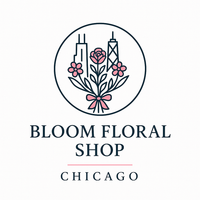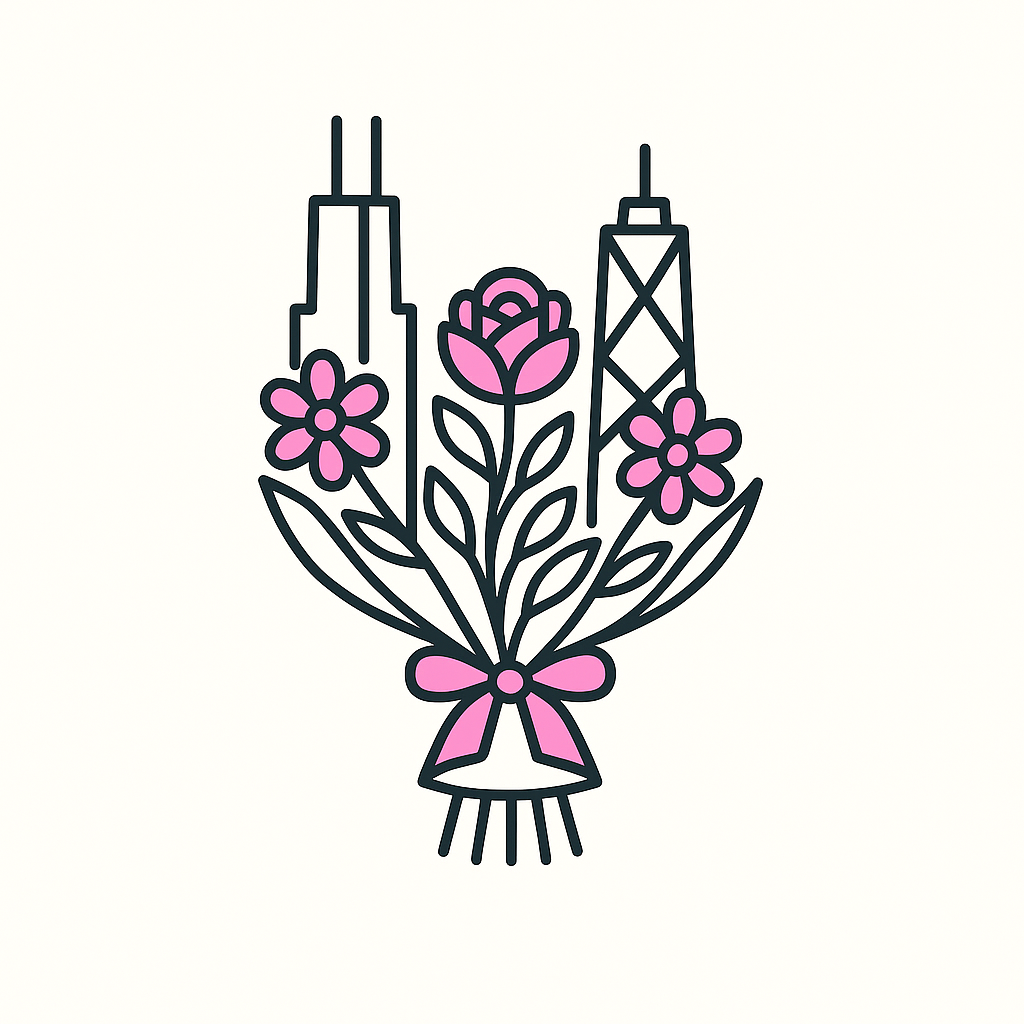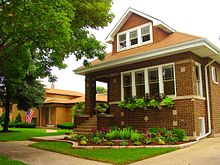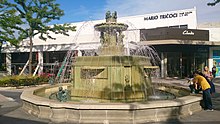Skokie, IL Florist | Same Day Flower Delivery IL 60076

Flower Delivery to Skokie, Illinois - Skokie Florist
Skokie, Illinois
|
Skokie, Illinois
|
|
|---|---|
|
Village
|
|
| Village of Skokie | |
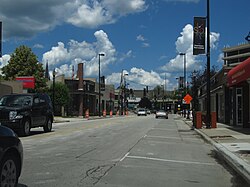
Downtown Skokie in 2013
|
|
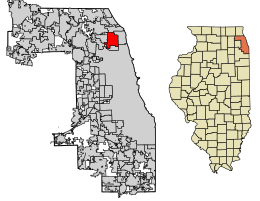
Location of Skokie in Cook County, Illinois.
|
|

Location of Illinois in the United States
|
|
| Coordinates: 42°02′01″N 87°43′58″WCoordinates: 42°02′01″N 87°43′58″W | |
| Country |
|
| State | Illinois |
| County | Cook |
| Township | Niles |
| Incorporated | 1888 |
| Government | |
| • Type | Council–manager |
| • Mayor | George Van Dusen (D)[1] |
| Area | |
| • Total | 10.06 sq mi (26.07 km2) |
| • Land | 10.06 sq mi (26.07 km2) |
| • Water | 0.00 sq mi (0.00 km2) 0% |
| Population
(2010)
|
|
| • Total | 64,784 |
| • Estimate
(2019)[3]
|
62,700 |
| • Density | 6,230.13/sq mi (2,405.45/km2) |
| Up 2.27% from 2000 | |
| Standard of living (2011) | |
| • Per capita income | $32,169 |
| • Median home value | $297,900 |
| ZIP code(s) |
60076, 60077, 60203
|
| Area code(s) | 847 & 224 |
| Geocode | 70122 |
| FIPS code | 17-70122 |
| Website | skokie |
| Demographics (2010)[4] | |||
|---|---|---|---|
| White | Black | Asian | |
| 60.3% | 7.3% | 25.5% | |
| Islander | Native | Other | Hispanic (any race) |
| 0.02% | 0.2% | 6.7% | 8.8% |
Skokie (/ˈskoʊki/; formerly Niles Center) is a village in Cook County, Illinois, United States, neighboring the City of Chicago's northern border. Skokie lies approximately 15 miles (24 km) north of Chicago's downtown loop. Its name comes from a Potawatomi word for "marsh."[5] For many years, Skokie promoted itself as "The World's Largest Village."[6] Its population, according to the 2010 census, was 64,784. Skokie's streets, like that of many suburbs, are largely a continuation of the Chicago street grid, and the village is served by the Chicago Transit Authority, further cementing its connection to the city.
Skokie was originally a German-Luxembourger farming community, but was later settled by a sizeable Jewish population, especially after World War II. At its peak in the mid-1960s, 58% of the population was Jewish, the largest percentage of any Chicago suburb. At nearly 30%, Skokie still has a large Jewish population and an active Chabad.[7] It is home to the Illinois Holocaust Museum and Education Center, which opened in northwest Skokie in 2009.
Skokie has received national attention twice for court cases decided by the United States Supreme Court. In the mid-1970s, it was at the center of National Socialist Party of America v. Village of Skokie, in which a neo-Nazi group, backed by the American Civil Liberties Union, invoked the First Amendment in an attempt to schedule a neo-Nazi rally in Skokie. At the time, Skokie had a significant population of Holocaust survivors. Skokie ultimately lost that case, though the rally was never held.[8] In 2001, although Skokie was not a direct party to the case, a decision by the village regarding land use led the court to reduce the power of the United States Environmental Protection Agency.[citation needed]
Geography[edit]
According to the 2010 census, Skokie has a total area of 10.06 square miles (26.06 km2), all land.[9] The village is bordered by Evanston to the east, Chicago to the southeast and southwest, Lincolnwood to the south, Niles to the southwest, Morton Grove to the west, Glenview to the northwest, and Wilmette to the north.
The village's street circulation is a street-grid pattern, with major east-west thoroughfare every half-mile: Old Orchard Road, Golf Road, Church Street, Dempster Street, Main Street, Oakton Street, Howard Street, and Touhy Avenue. The major north-south thoroughfares are Skokie Boulevard, Crawford Avenue, and McCormick Boulevard; the major diagonal streets are Lincoln Avenue, Niles Center Road, East Prairie Road and Gross Point Road.
Skokie's north-south streets continue the street names and (house number) grid values of Chicago's north-south streets – with the notable exceptions of Cicero Avenue, which is renamed Skokie Boulevard in Skokie, and Chicago's Pulaski Road retains its original Chicago City name, Crawford Avenue. The east-west streets continue Evanston's street names, but with Chicago grid values, such that, Evanston's Dempster Street is 8800 north, in Skokie addresses.
History[edit]
|
This section needs additional citations for verification. (April 2012) (Learn how and when to remove this template message)
|
Beginnings[edit]
In 1888, the community was incorporated as Niles Centre. About 1910, the spelling was Americanized to "Niles Center". However, the name caused postal confusion with the neighboring village of Niles. A village-renaming campaign began in the 1930s. In a referendum on November 15, 1940, residents chose the Native American name "Skokie" over the name "Devonshire."
During the real estate boom of the 1920s, large parcels were subdivided; many two- and three-flat apartment buildings were built, with the "Chicago"-style bungalow a dominant architectural specimen. Large-scale development ended as a result of the Great Crash of 1929 and consequent Great Depression. It was not until the 1940s and the 1950s, when parents of the baby boom generation moved their families out of Chicago, that Skokie's housing development began again. Consequently, the village developed commercially, an example being the Old Orchard Shopping Center, currently named Westfield Old Orchard.
During the night of November 27–28, 1934, after a gunfight in nearby Barrington that left two FBI agents dead, two accomplices of notorious 25-year-old bank-robber Baby Face Nelson (Lester Gillis) dumped his bullet-riddled body in a ditch along Niles Center Road adjoining the St. Peter Catholic Cemetery,[10] a block north of Oakton Street in the town.[11]
The first African-American family to move to Skokie arrived in 1961, and open-housing activists helped to integrate the suburb subsequently.[12]
Name[edit]
The name of the town was changed from "Niles Center" to "Skokie" by referendum in 1940. "Skokie" had previously been used as the name for the marshland on which much of the town was built; the term "Skokie marsh" was being used by local botanists, notably Henry Chandler Cowles, as early as 1901.[13] Maps long named the Skokie marsh as Chewab Skokie, a probable derivation from Kitchi-wap choku, a Potawatomi term meaning "great marsh".[14]
Virgil Vogel's Indian Place Names in Illinois (Illinois State Historical Society, 1963) records the name Skokie as:
deriving directly from skoutay or scoti and variant Algonquian words for fire. The reference is to the fact that marshy grasslands, such as occurred in the Skokie region, were burned by the Indians to flush out the game.
In Native Placenames of the United States (U. of Oklahoma Pr, 2004), William Bright lists Vogel's Potawatomi derivation first, but adds reference to the Ojibwa term miishkooki ("marsh") recorded in the Eastern Ojibwa-Chippewa-Ottawa Dictionary (Mouton, 1985), by Richard A. Rhodes.
The 1940 change of name may also have been influenced by James Foster Porter, a Chicago native, who had explored the "Skoki Valley" in Banff National Park in Canada in 1911 and became captivated by the name. Porter supported the name "Skokie" in the referendum when he returned to America.[15]
Supreme Court rulings[edit]
Twice in its history, Skokie has been the focal point of cases before the United States Supreme Court. National Socialist Party of America v. Village of Skokie, 432 U.S. 43 (1977), involved a First Amendment issue. Solid Waste Agency of Northern Cook County (SWANCC) v. U.S. Army Corps of Engineers, 531 U.S. 159 (2001) touched upon the Commerce Clause.
National Socialist Party of America v. Village of Skokie[edit]
In 1977 and 1978, Illinois neo-Nazis of the National Socialist Party of America (NSPA) attempted to hold a march in Skokie, far from their headquarters on Chicago's south side. Originally, the neo-Nazis had planned a political rally in Marquette Park in Chicago. The park is located in what was then a predominantly all-white neighborhood, similar to the situation in 1966, when a crowd of 4,000 Marquette Park residents gathered to watch Martin Luther King Jr. lead a march, some waving Confederate flags or throwing bottles, bricks and rocks at the protesters; King was knocked to his knees when struck by a rock.[16] However, the Chicago authorities thwarted the NSPA's plans.[8]
Seeking another free-speech political venue, the NSPA group chose to march on Skokie. Given the many Holocaust survivors living in Skokie, the village's government thought the Nazi march would be disruptive, and refused the NSPA permission to hold the event. The NSPA appealed that decision, and the American Civil Liberties Union interceded on their behalf, in National Socialist Party of America v. Village of Skokie. An Illinois appeals court raised the injunction issued by a Cook County Circuit Court judge, ruling that the presence of the swastika, the Nazi emblem, would constitute deliberate provocation of the people of Skokie. However, the Court also ruled that Skokie's attorneys had failed to prove that either the Nazi uniform or their printed materials, which it was alleged that the Nazis intended to distribute, would incite violence.[17]
Moreover, because Chicago subsequently lifted its Marquette Park political demonstration ban, the NSPA ultimately held its rally in Chicago. The attempted Illinois Nazi march on Skokie was dramatized in the television movie, Skokie, in 1981. It was satirized in The Blues Brothers movie in 1980.
Migratory bird rule[edit]
In 2001, Skokie's decision to use an isolated wetland as a solid waste disposal site resulted in a lawsuit. Ultimately, the case went all the way to the United States Supreme Court, and resulted in an overturn of the federal migratory bird rule. See Solid Waste Agency of Northern Cook Cty. v. Army Corps of Engineers for more information.
Parks, recreation and attractions[edit]
The Skokie Park District maintains public spaces and historical sites within its more than 240 acres (0.97 km2) of parkland and in its ten facilities. The district is a recent winner of the national "Gold Medal for Excellence" in parks and recreation management. Every May since 1991, the park district hosts the Skokie Festival of Cultures to celebrate the village's diverse ethnic composition.
Westfield Old Orchard, an upscale shopping center, is one of the country's first and is the third largest mall by total square footage in Illinois. One of five in the Chicago area of the popular burger chain "Shake Shack" is located there.[18] Additionally, shoppers have the option of eating at Epic Burger, along with multiple other restaurants in the mall.[19]
The Skokie Northshore Sculpture Park is situated along the North Shore Channel between Dempster Street and Touhy Avenue on the east side of McCormick Boulevard. The first sculptures were built in the park in 1988 and it now has over 70 sculptures. Three areas are toured May through October of each year, on the last Sunday of the month with a presentation by a docent.[20] Just north of the sculpture garden is a statue to Mahatma Gandhi with five of his famous quotations engraved around the base. This was dedicated on October 2, 2004.[21]
In addition to municipally-managed public spaces, the village is also home to the North Shore Center for the Performing Arts, encompassing Centre East, Northlight Theatre and the Skokie Valley Symphony Orchestra. The facility celebrated its 20th anniversary in 2016.[22]
The Illinois Holocaust Museum and Education Center opened in Skokie on April 19, 2009.[23]
Library[edit]
On October 7, 2008, the Skokie Public Library received the 2008 National Medal for Museum and Library Service from First Lady Laura Bush in a ceremony at the White House.[24] The National Medal is awarded annually by the federal Institute of Museum and Library Services, the primary source of federal support for the nation's 122,000 libraries and 17,500 museums, to five libraries and five museums. The library's cultural programming and multilingual services were cited in the award presentation. Skokie Public Library is the first public library in Illinois to be awarded the medal.[25]
Additionally, the Skokie Library also offers a bookmobile service that provides a mini-library around the community.[26]
Valley Line Trail[edit]
The Valley Line Trail is a multi-use trail connecting the northwest side of Chicago to the communities of Lincolnwood and Skokie.[27][28] The Chicago portion of the trail has been referred to as the Sauganash Trail,[29] and as the Valley Line Trail as the trail continues into Chicago's northern suburbs. The municipalities of Glenview, Wilmette, Northfield and Skokie are currently developing plans to build 4.5 miles of new multi-use trail following the existing ComEd and Union Pacific ROW in northern Cook County.[30]
Economy[edit]
The village's AAA bond rating attests to strong economic health via prudent fiscal management. In 2003, Skokie became the first municipality in the United States to achieve nationally accredited police, fire, and public works departments, and a Class-1 fire department, per the Insurance Services Office (ISO) ratings. Likewise, in 2003 Money magazine named Skokie one of the 80 fastest-growing suburbs in the U.S.
Besides strong manufacturing and retail commerce bases, Skokie's economy will add health sciences jobs; in 2003, Forest City Enterprises announced their re-development of the vacant Pfizer research laboratories, in downtown Skokie, as the Illinois Science + Technology Park, a 23-acre (93,000 m2) campus of research installations—2 million square feet (190,000 m2) of chemistry, genomics, toxicology laboratories, clean rooms, NMR suites, conference rooms, etc.). In 2006, NorthShore University HealthSystem announced installing their consolidated data center operations at the park, adding 500 jobs to the economy. Map maker Rand McNally, private label cooperative Topco and online grocer Peapod are also headquartered in Skokie.
Top employers[edit]
According to the Village's 2018 Comprehensive Annual Financial Report,[31] the top employers in the village are:
| # | Employer | # of Employees |
|---|---|---|
| 1 | NorthShore University HealthSystem | 2,410 |
| 2 | Federal-Mogul | 1,279 |
| 3 | Niles Township High School District 219 | 950 |
| 4 | Macy's | 910 |
| 5 | Georgia Nut Company | 815 |
| 6 | Nordstrom | 618 |
| 7 | Village of Skokie | 498 |
| 8 | Illinois Circuit Court of Cook County | 465 |
| 9 | Skokie Park District | 432 |
| 10 | Generation Brands | 417 |
Demographics[edit]
| Historical population | |||
|---|---|---|---|
| Census | Pop. | %± | |
| 1900 | 529 | — | |
| 1910 | 568 | 7.4% | |
| 1920 | 763 | 34.3% | |
| 1930 | 5,007 | 556.2% | |
| 1940 | 7,172 | 43.2% | |
| 1950 | 14,832 | 106.8% | |
| 1960 | 59,364 | 300.2% | |
| 1970 | 68,322 | 15.1% | |
| 1980 | 60,278 | −11.8% | |
| 1990 | 59,432 | −1.4% | |
| 2000 | 63,348 | 6.6% | |
| 2010 | 64,784 | 2.3% | |
| 2019 (est.) | 62,700 | [3] | −3.2% |
| U.S. Decennial Census[32] | |||
Per the census[33] of 2000, the Village of Skokie was composed of 63,348 people who formed in 23,223 households containing 17,045 families. The village's population density was 6,308.70 people per square mile (2,436.1/km2) living in 23,702 housing units (average population density: 2,360.4/square mile [911.5/km2]). The village's racial composition was: 65.6% White, 4.51% African American, 0.17% Native American, 21.28% Asian, 0.03% Pacific Islander, 1.86% from other races, 3.23% from two or more races. The Hispanic and Latino population, of any race, made up 5.71% of the village.
The 23,223 households comprise: 32.2% with minority-age children (younger than 18 years), 60.5% were cohabiting married couples, 9.9% of households were headed by a woman (with no husband present), and 26.6% were non-family cohabitants, 23.6% were single-person households, and 13.6% included an elder person (65 years of age or older). The average Skokie household size was 2.68 persons, and the average household family size was 3.20 persons.
Chronologically, Skokie's age population comprises: 23.0% of minority age (younger than 18 years); 7.0% aged from 18 to 24 years; 25.0% aged from 25 to 44, 25.5% aged from 45 to 64, and 19.6% aged 65 years and older. The median Villager's age is 42 years; for every 100 women younger than 18 years, there were 90.1 men; for every 100 women age 18 and older, there were 85.2 men.
Financially, Skokie's median household income was $57,375; the median family income was $68,253; a man's median income was $44,869; a woman's median income was $33,051. The per capita income is $27,136; 4.2% of families and 5.4% of the population are below the poverty line income, including 5.9% of children under 18 and 5.3% of elders aged 65 years and older.
As of the 2010 US Census, Skokie had a total of 64,784 people within its boundaries. The village's racial composition was 60.27% White, 7.26% African American, 0.19% Native American, 25.54% Asian, 0.02% Pacific Islander, 3.08% some other race, and 3.65% of mixed race. Hispanic and Latinos, of any race, made up 8.84% of the total population. There is a large Jewish population in Skokie and many of the surrounding areas.
Skokie also contains a sizeable Assyrian population. Some Assyrian American organizations, such as the Assyrian Universal Alliance Foundation, report that Assyrians make up the largest ethnic group in Skokie, with the population estimate being upwards of 20,000. The population of the local high school district, Niles Township High School District 219, is reported to be about 30% Assyrian, making them the largest ethnic group at the school district as well.[34][35][36]
Public transportation[edit]
The Chicago "L"s Yellow Line terminates at the Dempster Street station in Skokie. Construction has been completed on a new Yellow Line train station at Oakton Street, to serve downtown Skokie and environs. It opened April 30, 2012.[37] Additionally, the CTA is commissioning an Alternative Analysis Study on the extension of the Yellow Line terminal to Old Orchard Road for Federal Transit Administration New Start grants.[38] The New Starts program allows federal funds to be used for capital projects provided all solutions for a given problem (i.e., enabling easy transportation for reverse commuters to Old Orchard Mall) is considered. The solution recommended by the CTA is the elevation of the Yellow Line north of Searle Parkway to a rebuilt Dempster Street station, then following abandoned Union Pacific Railroad tracks and the east side of the Edens Expressway to a new terminal south of Old Orchard Road. Currently this solution needs to undergo public commenting as well as FTA and CTA board approval to continue.[39]
Although the Yellow Line is the fastest transportation to and from the city, the village also is served by CTA and Pace bus routes. However, Greyhound Bus service to the Dempster Street train station has been discontinued. For automobile transport, Interstate 94, the Edens Expressway, traverses western Skokie, with interchanges at Touhy Avenue, Dempster Street, and Old Orchard Road.
Major highways[edit]
Major highways in Skokie include:
|
Interstate Highways |
US Highways |
Schools[edit]
Public schools[edit]
Primary school districts include:
- Skokie School District 68
- Skokie/Morton Grove School District 69
- Fairview South School District 72
- East Prairie School District 73
- Skokie School District 73.5
Niles Township High School District 219 operates public high schools.
A portion of the city is served by the Evanston/Skokie School District 65 and Evanston Township High School.[40]
High schools[edit]
- Niles North of District 219
- Niles West of District 219
- Niles Township District 219, known for its fine arts program, was awarded the Kennedy Center for Performing Arts Top program for fine arts education in the United States on April 27, 2007.
- Niles East High School closed in 1980 after community efforts to save the school failed.
Junior high schools[edit]
- Oliver McCracken Middle School (formerly Oakview Junior High) of District 73.5
- East Prairie School (Pre-K through 8th) of District 73
- Fairview South School of District 72
- Lincoln Junior High of District 69
- Old Orchard Junior High of District 68
- Chute Middle School in Evanston serves a small portion of Skokie residents of Evanston/Skokie District 65
Elementary schools[edit]
See the same map as middle schools.
- Jane Stenson School, (K through 5th) of District 68
- Devonshire School, (K through 5th) of District 68
- Highland School, (K through 5th) of District 68
- Madison School, (pre-K through 2nd) of District 69
- Edison School, (3rd through 5th) of District 69
- Fairview North formerly of District 72
- Fairview South School, (K through 8th) of District 72
- Elizabeth Meyer School, (pre-K and K) of District 73.5
- John Middleton School, (1st through 5th) of District 73.5
- East Prairie School, (Pre-K through 8th) of District 73
- Walker Elementary School, (K through 5th) of Skokie/Evanston District 65
- Dr. Bessie Rhodes Magnet School, (K through 8th) of Skokie/Evanston District 65, formerly Timber Ridge Magnet School (may be attended by Skokie students in District 65)
Religious day schools[edit]
Muslim elementary school[edit]
- MCC Academy (Pre-K through 8th)
Orthodox Jewish day schools[edit]
- Arie Crown Hebrew Day School (pre-K through 8th), boys and girls
- Cheder Lubavitch Hebrew Day School (pre-K through 8th), separate boys and girls programs
- Hillel Torah North Suburban Day School (pre-K through 8th), boys and girls
- Ida Crown Jewish Academy (9th through 12th), boys and girls
- Fasman Yeshiva High School (9th through 12th), boys only
Catholic schools[edit]
- St. Joan of Arc School (K-8)
Post-secondary education[edit]
- Oakton Community College (Ray Hartstein Campus) This is the site of the old Niles East High School. The original structure, built in the 1930s, was demolished in the 1990s.
- Hebrew Theological College, a private university. It was chartered in 1922 as one of the first Modern Orthodox Jewish institutions of higher education in America.
- National-Louis University has a campus near the Skokie Courthouse and is a high-ranking school for education.[41][who?]
Notable corporations[edit]
- Peapod, online grocer
- FelPro, now Federal-Mogul
- Mayfair Games
- Rand McNally
- USRobotics
- Bell & Howell
- G.D. Searle, now Pfizer
Notable people[edit]
- Rob Ambrose, current head coach of Towson Tigers football team of Towson University
- Louie Belpedio NHL player for the Minnesota Wild
- Mike Byster, mathematician, mental calculator and math educator
- Jovita Carranza (born 1949), 26th Administrator of the Small Business Administration (2020–present). She is a past resident of Skokie.[42]
- Bobby Ciraldo, filmmaker and web-based artist
- Bart Conner, Olympic gymnast, 1984 gold medalist
- David Cromer, theatre director and stage actor
- Robert Feder, media blogger, former columnist for Chicago Sun-Times
- Brenda A. Ferber, author of children's literature
- Ken Goldstein, singer and author
- Woody Goss, musician
- Nancy Lee Grahn, actress
- Phil Handler (1908–1968), NFL football player and coach
- Erin Heatherton, fashion model and actress
- Amanda Jones, 1973 Miss USA
- Shelly Kagan, philosopher
- David Kaplan, columnist, radio and television personality
- Jonathan Kite, actor and comedian
- George Kotsiopoulos, magazine editor, fashion consultant, TV personality
- Ken Kramer, former Congressman
- Lou Lang, politician
- Rashard Mendenhall,[43] former running back in the National Football League
- Abdel Nader, professional basketball player for the Oklahoma City Thunder of the National Basketball Association
- Emily Naphtal, figure skater
- Brent Novoselsky, NFL tight end
- Noam Pikelny, banjo player, known for association with string quintet Punch Brothers
- Menachem Posner, Skokie native and now staff editor at Chabad.org
- Esther Povitsky, standup comedian, actress and podcast host
- Robert Reed, actor
- Matt Reichel, politician
- Clarke Rosenberg (born 1993), American-Israeli basketball player in the Israel Basketball Premier League
- Jessy Schram, actress
- John Gideon Searle, businessman
- Randy Suess, Co-founder of CBBS, the first Bulletin Board System (BBS) ever brought online.
- Calvin Sutker, politician and lawyer
- Azhar Usman, Indian-American Muslim standup comedian, actor, writer, and producer, *Asif Javed
References[edit]
Notes[edit]
- ^ "Meet the Leaders: Skokie Mayor George Van Dusen". Skokie, IL Patch. 12 September 2013. Retrieved 3 April 2020.
- ^ "2019 U.S. Gazetteer Files". United States Census Bureau. Retrieved July 14, 2020.
- ^ Jump up to:a b "Population and Housing Unit Estimates". United States Census Bureau. May 24, 2020. Retrieved May 27, 2020.
- ^ "Profile of General Population and Housing Characteristics: 2010 Demographic Profile Data (DP-1): Skokie village, Illinois". U.S. Census Bureau, American Factfinder. Archived from the originalon February 12, 2020. Retrieved March 19, 2013.
- ^ Newcomer's Handbook for Moving to and Living in Chicago. First Books. 2004. p. 73. ISBN 0912301538.
- ^ "Archived copy". Archived from the original on 2014-08-21. Retrieved 2010-06-27.
- ^ Reese, Joel. "A Field Guide to Skokie". Chicago magazine. Retrieved 30 December 2019.
- ^ Jump up to:a b Grossman, Ron. "'Swastika war': When the neo-Nazis fought in court to march in Skokie". chicagotribune.com.
- ^ "G001 - Geographic Identifiers - 2010 Census Summary File 1". United States Census Bureau. Archived from the original on 2020-02-13. Retrieved 2015-12-25.
- ^ St. Peter Catholic Cemetery, 8115 Niles Center Rd., Skokie 60077
- ^ "Trace Outlaw Nelson on Death Ride." Chicago Tribune. November 29, 1934. p. 1
- ^ Yackley, Sel (30 April 1967). "Integration Eases into Highland Pk". Chicago Tribune.
- ^ Henry Chandler Cowles (1901). The Plant Societies of Chicago and Vicinity. Geographic Society of Chicago. p. 68.
- ^ Shabica, Charles. "Swamp Secrets: The Natural and Unnatural Evolution of the Skokie Lagoons". Winnetka Historical Society. Winnetka Historical Society Gazette. Retrieved January 21, 2021.
- ^ Barnes, Christine (1999). Great Lodges of the Canadian Rockies. Bend, Oregon: W.W. West. p. 130. ISBN 0-9653924-2-2.
- ^ Wilkerson, Isabel (2010). The Warmth of Other Suns. New York City: Random House. p. 388. ISBN 9780679444329.
- ^ Dubey, Diane (1977-07-14). "No swastikas allowed : Lift march injunction". The Skokie Life.
- ^ "Shake Shack".
- ^ "Dining at Westfield Old Orchard". www.westfield.com. Retrieved 2019-04-21.
- ^ Skokie Northshore Sculpture Park
- ^ "SkokieNet - Social Mobile Apps". Archived from the originalon 2006-10-10. Retrieved 2006-10-29.
- ^ "History".
- ^ "Illinois Holocaust Museum Opens in Skokie: Bill Clinton, Elie Wiesel Address Crowd of Thousands". The Huffington Post. 2009-04-19. Retrieved 2009-04-20.
- ^ "News Releases". Archived from the original on 2008-12-04. Retrieved 2008-10-22.
- ^ "Chicago Suburbs News - Chicago Tribune".
- ^ "Bookmobile".
- ^ Zoline, Jeff (2016-12-30). "Lincolnwood Builds New Segments of the Valley Line Trail and the Weber Spur". Streetsblog Chicago. Retrieved 3 November 2019.
- ^ "Valley Line Trail – Recreation Path". Retrieved 2019-11-03.
- ^ "Sauganash Trail Park". Retrieved 2019-11-03.
- ^ "Skokie Valley Trail plan". Retrieved 2019-11-03.
- ^ Village of Skokie CAFR
- ^ "Census of Population and Housing". Census.gov. Retrieved June 4, 2015.
- ^ "U.S. Census website". United States Census Bureau. Retrieved 2008-01-31.
- ^ "At a Glance: The Assyrian Community in Chicago" (PDF).
-
^ Snell, Joe (August 2019). "Candlelight march highlights Assyrian Martyr's Day in Skokie". The Assyrian Journal. Retrieved August 25, 2020.
The Assyrian Universal Alliance Foundation (AUAF) estimates roughly 100,000 Assyrians in the Chicagoland area and upwards of 20,000 in Skokie. That number, Mayor Van Dusen said, has continued to rise over the last decade.
-
^ "5K Walk Calls Attention to Assyrian Suffering in Iraq". Assyrian International News Agency. September 21, 2019. Retrieved August 25, 2020.
The walk was held in Skokie, a suburb of Chicago which is home to 20,000 Assyrians.
- ^ "Oakton-Skokie Yellow Line Station Opens". Chicago Transit Authority. April 30, 2012. Retrieved April 30, 2012.
- ^ "Yellow Line Extension Alternatives Analysis Study". Retrieved 2009-07-05.
- ^ "Yellow Screen 2 Presentation April 30, 2009 (text)". Retrieved 2009-07-05.
- ^ "EVANSTON TOWNSHIP HIGH SCHOOL 2018-19 School Profile" (PDF). Evanston Township High School. Retrieved 2019-07-17.
- ^ "National Louis University | Ranking & Review". www.4icu.org. Retrieved 2019-12-03.
- ^ Sweet, Lynn (January 7, 2020). "Senate confirms Jovita Carranza, from Skokie, to be new SBA chief". Chicago Sun-Times. Retrieved June 29, 2020.
- ^ "Archived copy". Chicago Sun-Times. Archived from the original on 2013-10-16. Retrieved 2013-10-08.
Bibliography[edit]
- When the Nazis Came to Skokie: Freedom for Speech We Hate, Philippa Strum, University Press of Kansas (31 Mar 1999), ISBN 0-7006-0941-5
- Skokie, 1888–1988: A centennial history, Richard Whittingham, Village of Skokie (1988), ASIN B00071EORW
- Steven J. Heyman (ed.), Controversies in Constitutional Law: Hate Speech and the Constitution (New York and London: Garland Publishing Inc., 1996, Vol. II)
- The industrialization of the Skokie area, James Byron Kenyon, University Of Chicago Press (1954), ASIN B0007DMRX8
External links[edit]
| Wikimedia Commons has media related to Skokie, Illinois. |
-
Official website

- Brief history of Skokie
- Skokie Historical Society
- Skokie Public Library
- The ACLU and the Skokie march (pdf), via Chicago History Museum
- Skokie Festival of Cultures
- Skokie LocalWiki
COURTESY OF WIKIPEDIA.COM
